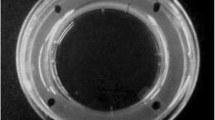Abstract
The interactions of the collembolan insect Proisotoma minuta with ectomycorrhizal and/or pathogenic fungi was examined in three experiments: (1) in vitro analysis of feeding patterns, (2) in vitro food preference test, and (3) in situ analysis of ectomycorrhizal colonization in relation to population density. The ectomycorrhizal fungi Laccaria laccata, Pisolithus tinctorius, Suillus luteus, Thelephora terrestris and the pathogenic fungi Rhizoctonia solani were employed in all experiments. In vitro and in situ experiments revealed that Pr. minuta consumed all the ectomycorrhizal fungi tested but the feeding pattern and consumption varied with each isolate. In a comparative in vitro feeding preference test, where Pr. minuta was given a choice, R. solani was grazed more heavily than the ectomycorrhizal fungi. Among the ectomycorrhizal fungi examined, Pi. tinctorius was consumed significantly less than L. laccata, S. luteus or T. terrestris in the presence of R. solani. A 10-week in situ analysis of loblolly pine (Pinus taeda L.) seedling root systems inoculated with Pr. minuta revealed that ectomycorrhizal colonization was significantly less than that of control plants (without Pr. minuta). Collectively, these data suggest that mycophagous Collembola may play a major role in the distribution and biomass of ectomycorrhizal fungi in the rhizosphere of tree seedlings.
Similar content being viewed by others
References
Anderson JM, Healey IN (1972) Seasonal and interspecific variation in major components of the gut contents of some woodland Collembola. J Anim Ecol 41:359–368
Curl EA (1979) Effect of mycophagous collembola on Rhizoctonia solani and cotton-seedling disease. In: Schippers B, Gams W (eds) Soil-borne plant pathogens. Academic Press, London, pp 253–269
Curl EA, Truelove B (1986) The rhizosphere. Springer, Berlin Heidelberg New York
Curl EA, Gudauskas RT, Harper JD, Peterson CM (1985) Effects of soil insects on populations and germination of fungal propagules. In: Ecology and management of soilborne plant pathogens. American Phytopathological Society, St Paul, Minn, pp 20–23
Dixon RK, Hiol Hiol F (1992) Mineral nutrition and growth of Eucalyptus camaldulensis and Pinus caribaea inoculated with Pisolithus tinctorius and Telephora terrestris. Commun Soil Sci Plant Anal 23:1387–1396
Dixon RK, Wright GM, Garrett HE, Cox GS (1981) Container and nursery-grown black oak seedlings inoculated with Pisolithus tinctorius: growth and ectomycorrhizal development during seedling production period. Can J For Res 11:487–491
Dixon RK, Rao MV, Garg VK (1993) Salt stress affects in vitro growth and in situ symbioses of ectomycorrhizal fungi. Mycorrhiza 3:63–68
Finlay RD (1985) Interactions between soil microarthropods and endomycorrhizal relationships of higher plants. In: Fitter AH, Atkinson D, Lead DJ, Usher MB (eds) Ecological interactions: plants, microbes and animals. Blackwell, Oxford, pp 319–329
Gunn A, Cherrett JM (1993) The exploitation of food reserves by soil meso- and macroinvertebrates. Pedobiologia 37:303–320
Harley JL, Smith SE (1983) Mycorrhizal symbiosis. Academic Press, New York
Hoagland DR, Arnon DI (1950) The water culture method for growing plants without soil. Calif Agric Exp Sta Circ
Lagerlof J, Andren O (1991) Abundance and activity of Collembola, Protura and Diplura (Insecta, Apterygota) in four cropping systems. Pedobiologia 35:337–350
Marx DH (1969) The influence of ectotropic mycorrhizal fungi on the resistance of pine roots to pathogenic infections. I. Antagonism of mycorrhizal fungi to root pathogenic fungi and soil bacteria. Phytopathology 59:153–163
Marx DH, Bryan WC (1975) Growth and mycorrhizal fungi development of loblolly pine seedlings in fumigated soil infested with the fungal symbiont Pisolithus tinctorius. For Sci 21:245–254
Perry DA, Molina R, Amaranthus MP (1987) Mycorrhizae, mycorrhizosphere and reforestation: current knowledge and research needs. Can J For Res 17:929–940
Shaw PJA (1985) Grazing preferences of Onychiurus armatus (Insecta: collembola) for mycorrhizal and saprophytic fungi of pine plantations. In: Fitter AH, Atkinson D, Lead DJ, Usher MB (eds) Ecological interactions in soil: plants, microbes and animals. Blackwell, Oxford, pp 33–36
Steel RGD, Torrie JH (1980) Principles and procedures of statistics, 2nd edn. McGraw-Hill, New York
Tan KH, Sihanouth P, Todd RL (1978) Formation of humic acid like compounds by the ectomycorrhizal fungus Pisolithus tinctorius. Soil Sci Soc Am J 42:906–908
Testerink GJ (1982) Metabolic adaptations to seasonal changes in humidity and temperature in litter inhabiting springtails. Oikos 40:334–340
Wiggins EA, Curl EA (1979) Interactions of collembola and microflora of cotton rhizosphere. Phytopathology 69:244–249
Wiggins EA, Curl EA, Harper JD (1979) Effects of soil fertility and cotton rhizosphere on populations of collembola. Pedobiologia 19:77–82
Author information
Authors and Affiliations
Rights and permissions
About this article
Cite this article
Hiol Hiol, F., Dixon, R.K. & Curl, E.A. The feeding preference of mycophagous Collembola varies with the ectomycorrhizal symbiont. Mycorrhiza 5, 99–103 (1994). https://doi.org/10.1007/BF00202340
Issue Date:
DOI: https://doi.org/10.1007/BF00202340




